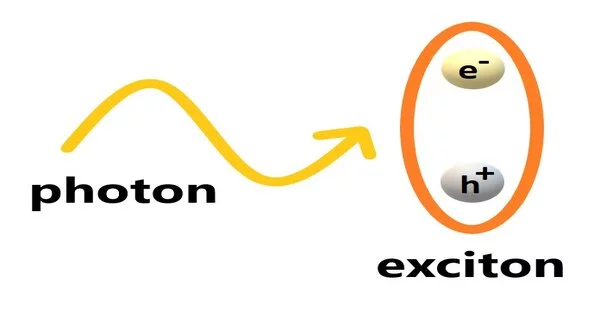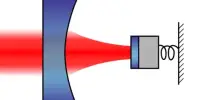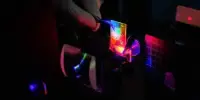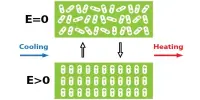Researchers created a polariton quantum box in a 2D material, achieving high polariton densities and a partially ‘coherent’ quantum state. The novel technique’s new insights could enable researchers to access striking ‘collective’ quantum phenomena in this material family, enabling ultra-energy efficient and high-performance future technologies. Using a ‘small’ 2D material on top of a ‘large’ layer, the researchers were able to trap and study polaritons, comparing them to freely moving polaritons.
Australian scientists created a quantum box for polaritons in a two-dimensional material, resulting in high polariton densities and a partially ‘coherent’ quantum state. The novel technique’s new insights could allow researchers to access striking ‘collective’ quantum phenomena in this material family, enabling ultra-energy efficient and high-performance future technologies.
The use of a ‘small’ 2D material (tungsten disulphate) on top of a ‘large’ heterostructure containing the same material was crucial to the construction of the quantum box. The researchers were able to carefully investigate and compare the properties of polaritons trapped in the box and freely moving polaritons as a result of this.
“We have shown that polaritons that form anywhere outside the quantum box can travel for many micrometers and be trapped and accumulate inside the box,” said lead researcher Dr. Matthias Wurdack (Australian National University).
We have shown that polaritons that form anywhere outside the quantum box can travel for many micrometers and be trapped and accumulate inside the box.
Dr. Matthias Wurdack
Why We Need Large Polariton Densities
Exciton-polaritons are a promising platform for future ultra-low energy electronics because they can flow without any wasted dissipation of energy, in a fully ‘coherent’ quantum state. A novel, 2D, atomically-thin semiconductors (TMDCs) are promising candidates for such future technologies because excitons are stable in these materials at room temperature.
(Room temperature operation is important in any viable, alternative low-energy technology, so that the energy required to supercool the device does not outweigh the gains.)
“However, this ‘dissipation less’ transport requires a phase transition to a macroscopically coherent quantum state, which only occurs at very large particle densities that are hard to access in 2D semiconductors,” explains group leader Prof Elena Ostrovskaya (also at the ANU).
“The new technique allows ANU researchers to create high polariton densities in an engineered ‘quantum box’.”
Exciton Polaritons: A Short Explainer
An ‘Exciton’ is a bound electron-hole pair that can be formed in a direct bandgap semiconductor by binding a photoexcited electron in the conduction band to a positively charged electron-vacancy (hole) in the valence band. When these excitons are combined with light, they form the desired hybrid light-matter particles known as ‘exciton-polaritons,’ which can travel through the semiconductor without dissipating energy in heat.
The ‘mixing’ is achieved by inserting a 2D semiconductor into a microcavity made up of two mirrors separated by a few hundred nanometers, which confines light. In such a device, excitons in the 2D semiconductor can strongly couple to the confined light, forming exciton-polaritons (also known as ‘polaritons’).
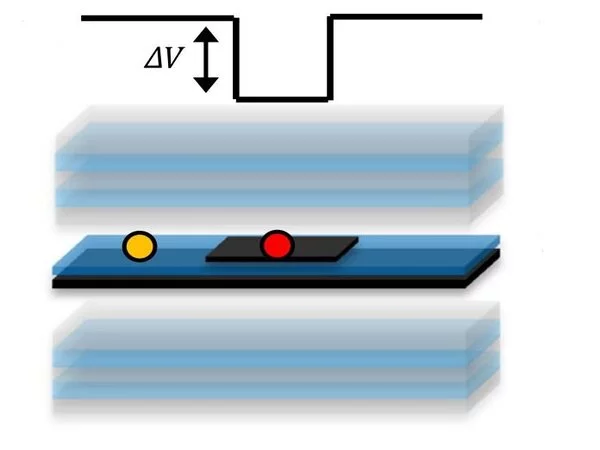
How to Build a Quantum Box
Exciton-polaritons interacting with each other in the microcavity/heterostructure device can undergo a phase transition to the dissipationless quantum state of Bose-Einstein condensate (BEC) or superfluid, which could be used in future technologies. At sufficiently high particle densities, this phase transition can be achieved at room temperature. The spatial confinement of polaritons inside a quantum box is a popular method for increasing particle density and thus their interactions.
Building a quantum box for exciton polaritons in 2D materials, on the other hand, is difficult because these materials are extremely fragile and easily damaged when using conventional nanofabrication techniques.
The FLEET/ANU researchers found a new way to build such a quantum box mechanically, without the need of nanofabrication machines that expose the fragile 2D materials to hot and abrasive particles.
This was accomplished by stacking a ‘small’ monolayer of TMDC tungsten disulfide (WS2) on top of a ‘large’ WS2 monolayer separated by ultrathin Ga2O3 glass inside the mirrored microcavity. The ‘small’ and ‘large’ sizes are relative to the particle wavelength of an exciton-polariton.
The smaller layer creates a ‘potential well’ because there is a stronger coupling of the exciton to light within its boundaries, which robs polaritons of potential energy, so they no longer have enough energy to escape the well. The design enables researchers to accumulate and confine polaritons within the potential well’s ‘box’ trap, greatly increasing polariton density within the box.
Study Confirms a Step Towards Desired Quantum State
Polariton characteristics could be compared both inside and outside the box trap, according to the researchers. They discovered that trapping causes energy redistribution towards lower energy states, indicating progress toward the desired quantum states of BEC and superfluidity.
Furthermore, the researchers discovered that trapping improves the macroscopic coherence of the polaritons even before the BEC phase is reached. This is because confined light has a much longer lifetime than WS2 excitons, and trapping greatly reduces the polariton gas’s phase fluctuations.
Surprisingly, the improved trap coherence was also achieved when the polaritons were exclusively created outside of the trapping region and populated the trap by traveling towards it across the sample.
Novel Materials
The semiconductors used in this study belong to the family of transition metal dichalcogenide crystals (TMDCs), which are layered crystals that are weakly bound via van-der-Waals interactions (similar to the graphite in pencils). Because the bonds between layers are so weak, researchers can ‘thin out’ these crystals relatively simply using the ‘Scotch tape’ method — first, famously, used by Geim and Novoselov to isolate 2D graphene in 2010.
Light at a specific wavelength strongly interacts with the monolayers when thinned to the monolayer limit (ie, one atom thin), directly creating excitons. (In bulk crystals, this process does not occur.)
Because excitons in 2D TMDCs are stable at room temperature, they are regarded as promising platforms for future technology. However, excitons in TMDCs have only weak effective interactions with one another, making ‘collective’ quantum phenomena like BEC and superfluidity difficult to achieve.
“While excitons in TMDCs interact strongly with light to form exciton-polaritons,” Matthias explains, “exciton-polaritons in TMDCs interact only weakly with each other. A very high polariton density could be a solution to this problem.”
